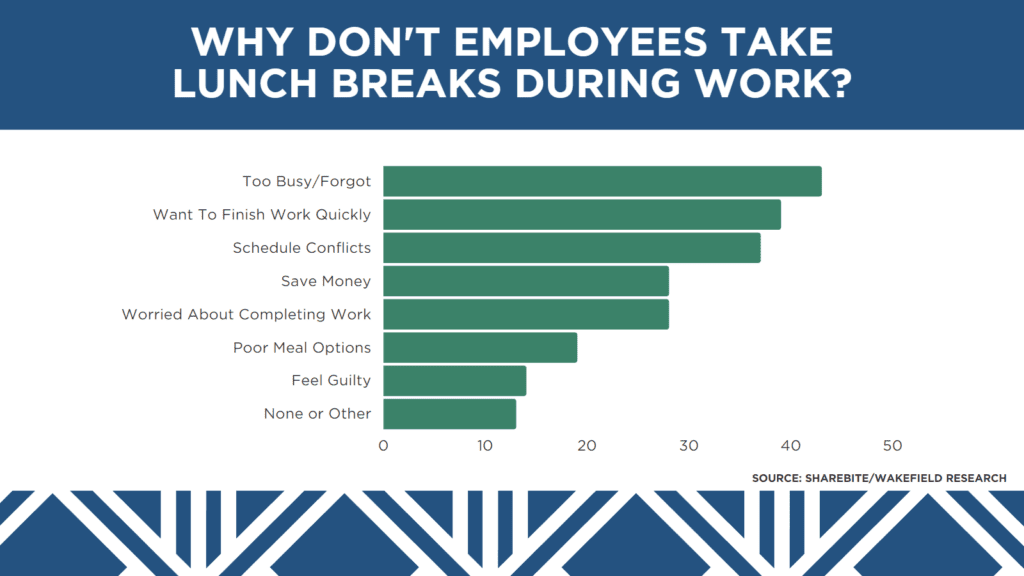

Have you taken your lunch break lately? You may not think it’s worth stopping what you’re doing long enough for a sandwich or a salad, but research is clear about the benefits of meal breaks.
Not only is a meal break a right in nearly half of all U.S. states, but a 2017 TORK study showed that workers who take their lunch break are more satisfied with their jobs and felt more efficient.
Unfortunately, many workers eat at their desk so they can crank out more work – or worse yet, skip lunch altogether! And the problem is amplified by fear of negative perception. Nearly a quarter of workers surveyed said they felt guilty or judged for taking their lunch break.
WHY ARE PEOPLE SKIPPING LUNCH?
A 2022 Sharebite survey in partnership with Wakefield Research found that 97% of people thought taking a lunch break improves their day. But those benefits aren’t enough to convince some workers to take their meal break. In fact, 14% of respondents said they never take a lunch break. While 1 in 5 people said they take the break two days per week at most.
So do people feel like they can’t take a break? Or is it something else?
The most common reasons for skipping lunch were being busy or simply forgetting, followed by wanting to finish work early. While being busy from time to time might not be overly concerning, another 28% of respondents said they skip their meal breaks because they worry about being able to finish their work, and another 14% say they work through lunch because they feel guilty for leaving.


>>KEEP AN EYE ON YOUR MENTAL HEALTH
WHAT IS IT ABOUT A LUNCH BREAK?
Neck and back pain can result from working at a desk, and the simple act of getting up and changing positions can combat the issue.
“Getting up, changing position and moving at lunch counters the effects of enforced immobility, enhancing your comfort for the rest of the day,” says Dr. Andrew Pipe, Chief of the Division of Prevention and Rehabilitation at the University of Ottawa Heart Institute.
Pipe says when people are stuck at their desk, they don’t tend to think about what they’re eating, opting for something quick instead.
“The kind of food people choose when they stay at their desk is not the healthiest,” Pipe says. “You can be more purposeful in your food choices when you get up and leave your office during lunch.”
Pipe notes there are serious mental benefits from the daily meal break as well. Taking the break lets your brain refresh and refuels you for the second half of the day. Eating while staying at your desk can lead to a less productive afternoon. In addition, the break allows employees downtime to ease stress and give you more of a sense of control.
>> WORK RELATED STROKES: WHAT THEY ARE AND HOW TO PREVENT THEM
Overall, taking a lunch break will make an employee happier than not taking one.
And this isn’t a mystery. Respondents to the Sharebite/Wakefield Research survey largely agreed that taking lunch gives them more energy, puts them in a better mood, and gives them time to think about things other than work.
EMPLOYERS SHOULD WANT WORKERS TO TAKE LUNCH BREAKS
The TORK survey, which asked 1,600 employees across the United States and Canada, found that employees weren’t willing to leave for their break and it was leading to burnout.
People surveyed who take a lunch break every day said they felt more valued as an employee and more likely to recommend their employer to other people.
The Sharebite/Wakefield Research survey found that 1 in 3 respondents would go to the office more often if offered free meals.
Two common characteristics of the companies that appeared on the Forbes 100 Best Companies to Work For list include employment retention and psychological and emotional health. In other words, if an employer can keep their staff happy long-term, then the company itself prospers.
CHOOSE TO LEAD BY EXAMPLE
Over 90% of employees say they are more likely to stay at a company where their employer encourages them to take a break.
How do people managers show employees that it’s OK to take breaks?
Take one yourself. Set an “At lunch” notification for remote employees, ask for suggestions for places to eat, or good places to go relax if you’re brown-bagging it.
Be visible. You could sit in the break room or ask one of your coworkers to go eat with you. The important part is to be seen taking some time to go eat lunch so your employees see that not only is it okay, it’s encouraged.
Note that work can wait. It’s okay for employees to finish what they’re doing in an hour. Not everything needs to be turned around at the drop of a hat, but employees may feel that way. Encourage them to put what they’re doing on hold and for them to get back to it after recharging.
WHAT DOES THE LAW SAY ABOUT LUNCH BREAKS?
There are no federal laws that dictate companies enforce lunch breaks for their employees, but there are a few rules that dictate when breaks are offered.
- When employers offer a break less than 20 minutes, federal law requires that workers be paid for that time. This also factors into calculating overtime.
- If a meal period is longer than 30 minutes, it’s not considered work time and can be unpaid.
Less than half of U.S. states and territories require employers to provide meal breaks to adult workers, according to the U.S. Department of Labor – and 7 of the 21 jurisdictions that do are in the Northeast.
| STATE | BASIC STANDARD | DETALLES |
| Connecticut | 30-minute break after first two hours worked, and before last two hours of a 7-and-a-half-hour shift | Excludes certain professional employees certified by the State Board of Education Excludes any employer who allows 30-minute break over 7-and-a-half-hour period. |
| Maine | 30-minute meal break for each 6 hours worked, except in an emergency | Not applicable if place of business has less than 3 employees working at a time and the nature of the work allows employees frequent paid breaks over the course of the workday |
| Massachusetts | 30-minute meal break for each 6 hours worked | During a meal break workers must be free from all duties During a break, workers are allowed to leave the workplace |
| Nuevo Hampshire | 30-minute break for every five hours worked | If employer can’t meet the 30-mionute requirement, then employee must be paid for work |
| Nueva York | 30-minute meal break between 11 a.m. and 2 p.m. for 6 hours worked | Factory workers are given a 60-minute break Any employees working 11 a.m. until 7 p.m. get an additional 20-minute break between 5-7 p.m. |
| Rhode Island | 20-minute break for every 6 hours worked | Increased to a 30-minute break after working 8 hours |
| Vermont | Workers are given “reasonable opportunities” to eat and use the bathroom over the course of the day | Universal application |
WHAT TO TAKE AWAY
Your lunch break may feel on the surface like just another part of your day. But the research is clear that taking a break makes you not only more productive, but happier, too!
Employers should know that meal breaks for workers are the furthest thing from lost time. When employers encourage their workers to take adequate lunch breaks, their employees feel more valued. They’re even more likely to recommend their workplace to other people!
So if you haven’t yet, go eat your lunch!




